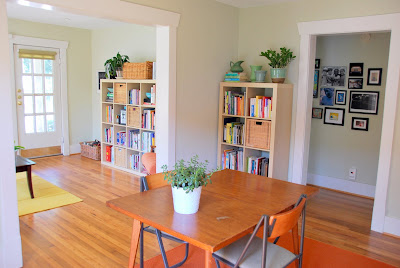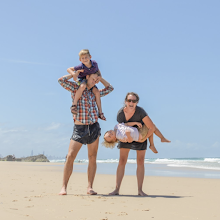I'm reading more of
Montessori from the Start, and I particularly enjoyed the section about clothing.
The authors assert that the main principles around selecting clothing should be:
- freedom of movement
- ease of dressing
- appropriate dress for the occasion
Although the principles seem simple, the implementation of them is pretty radical. For example, Montessorians do not select dresses for everyday use because they can inhibit a crawling child's movement (since the dress will hang down and is likely to get kneed). They also try to keep the feet and legs as bare as possible to facilitate movement (temperature permitting, of course).
In terms of ease of dressing, the goal is to facilitate the child's ability to dress him/herself as early as possible. The idea is that the more independent children are, the more secure and confident they feel about themselves as individuals. In terms of clothing that helps children dress themselves, the authors recommend pants that have an elastic waist with no buttons or snaps, shirts with wide necks to go over the head easily, pants that do not have tight cuffs at the ankles, and sweaters and coats that have buttons that fit easily into their holes.
I found the third principle--"appropriate dress for the occasion"--to be quite interesting. I guess it means you don't let your child wear a tutu to church, even though you are trying to cultivate their independence and their right to choose. It reminds me of a Montessori principle I learned in my training and implemented nearly every day in the classroom: "freedom with responsibility." In practice, this looks like setting out two appropriate options for the child to choose from.
I found this approach to dressing children to be very practical, yet a bit counter-cultural. I see so many parents who emphasize fashion over function when it comes to dressing their children. The authors ask this very poignant question:
"As a parent, are you seeing your child as a living human being with specific needs or as an object for your pleasure and self-enhancement?"
They go on to say: "It is particularly unfortunate when the child is dressed with so much adornment that we see not so much the child as her outward decoration. The message that we inadvertently send to the child is 'What is important about you is not what is inside of you but what is outside of you.'"
Whoa! What a powerful thought!
All of this reminds me of a lecture I went to by the author of
So Sexy So Soon: The New Sexualized Childhood and What Parents Can Do to Protect Their Kids. The author talked about how girls are choosing to dress in sexier and sexier ways at a younger age. It makes me wonder if the drive to dress oneself to attract attention and feel worthwhile stems--in part--from the ways in which we dress our children when they are younger?
And then, on the other hand, I do want Henry to have attractive clothing. I think aesthetics matter. I like beautiful and attractive things in my life.
I guess I should think about it like a
decision tree. The first question I ask myself when buying Henry clothing should be: Is it functional? Will this piece of clothing be comfortable to him? Will it facilitate his movement? Will it facilitate his independence with dressing?
If any of those answers are "no," then I should not buy the clothing, no matter how cute it is.
If the answers are "yes" to all of those questions, then I can ask, "Is it aesthetically appealing?" If it's not, then I shouldn't get it either.
In short, I'll shop for function and then fashion.
I put these ideas into practice this past weekend at the Baby GAP. I had a gift certificate that I wanted to spend, and I found the most adorable pair of jeans on the clearance rack. Since Henry won't really need to wear pants until this winter, I wanted to buy a large size. This winter, he will be approximately ten months old, and he will be much more involved in dressing himself. The jeans I wanted to get had a hook closure at the waist that only a grown-up would be able to close. I decided, instead, to opt for a pair of pants with an elastic waist. They aren't as cute as the jeans, but they will help Henry feel more accomplished and independent, which is way more important to me.
Now that I've babbled on and on about clothing, I'm starting to ask myself, "Aren't you wasting a lot of time and energy thinking about something as mundane as clothing?" But my response to myself is that the little things have big implications. How we interact with our children in small ways start to add up to something much larger. In the first six years of his life, Henry is constructing his personality, his sense of self. I want him to feel confident and competent, and if I can help cultivate those feelings by facilitating his ability to dress himself, then the effort is worth it.
(Editor's Note: This post doesn't even attempt to address all the other aspects that go into my clothing purchases: Where was this made? Were workers exploited? Could I buy this used instead to be better for the environment? Is this item budget-friendly? Is this item really needed?)
Oy vey!
































